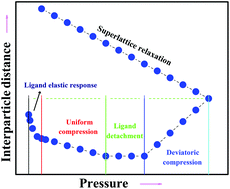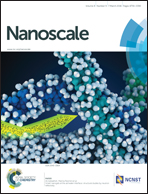Structural evolution and mechanical behaviour of Pt nanoparticle superlattices at high pressure†
Abstract
High pressure is an effective means for tuning the interparticle distances of nanoparticle (NP) superlattices and thus for modifying their physical properties and functionalities. In this work, we determined the evolution of inter-NP distances of a Pt NP superlattice with increasing pressure using an in situ synchrotron small-angle X-ray scattering (SAXS) technique in a diamond-anvil cell (DAC). Transmission electron microscopy (TEM) was used to characterize the microstructures of pre- and post-compression samples. Our results demonstrate that the evolution of Pt NP assemblies with increasing pressure consists of four stages: (1) ligand elastic response, (2) uniform compression, (3) ligand detachment from NP surfaces, and (4) deviatoric compression of ligands between neighboring NPs. By controlling the magnitudes of applied pressure and deviatoric stress, one can sinter NPs into novel architectures such as nanowires and nanoceramics.

- This article is part of the themed collection: 2016 Nanoscale HOT Article Collection

 Please wait while we load your content...
Please wait while we load your content...